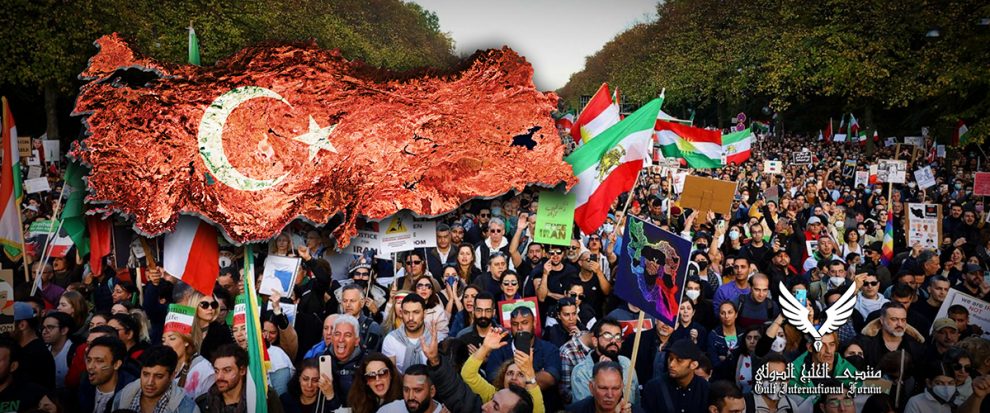After 22-year-old Mahsa Amini was killed by the Iranian “morality police” in early September 2022, Iranians across the country took to the streets, marking the most significant challenge to the theocratic government of Iran in four decades. Tehran’s response to the protests—a violent crackdown, an internet blackout, and mass arrests—has laid bare the brutality of the Iranian regime; it has not made any effort to concede to Iranian women demands, but instead has chosen to enforce veiling through coercive measures. The demonstrations have made equally clear that many women in Iran despise the headscarf and will continue to resist the clerical government for as long as it attempts to impose it on them.
The protests were welcomed by the majority of Turkish people, but for varying reasons. Conservative Turkish women who wear the headscarf voluntarily sided with Iranian women because they view the veil as a personal choice and decry the use of force by Iranian police. At the same time, Turkish seculars, opposed to the veil on principle, have unreservedly supported the protests. In spite of the near-unanimity of Turkish society, the Turkish government has remained largely silent on the protests in an attempt to preserve relatively cordial Turkish-Iranian relations.
A Complicated History
Analyzed in detail, it can be seen that Turkish people who adhere to a pious Islamic life and live accordingly support the Iranian women’s revolt because they oppose the imposition of the veil by force. While intra-family pressure to veil (or not to veil) is evident in Muslim communities—Turkish religious society is no exception, of course—state enforcement of headscarf laws is not welcomed in Turkey, where personal freedoms are enshrined into law and state intervention into private life is culturally unacceptable.
One reason for Turkey’s discomfort at mandatory veiling is its own history with the policy, which persisted for nearly 90 years. Immediately after the modern Turkish state was established in 1923, the secular government under Mustafa Kemal Atatürk launched a crackdown on outwardly religious Turks, who were regarded as anti-modern Turkish state. Although women were granted the right to vote in 1935, those wearing a headscarf were not allowed to run for public office. In addition, veil-wearing women were prohibited from wearing the headscarf in schools and other public institutions. In some instances, they were not allowed to enter state buildings, since their clothes were regarded as non-compliant with the state’s laiklik (secular) policies. Hostility against veiled Turkish women reached its zenith in the late 1990s, when they were openly demonized by many Turkish politicians and officials.
Although the headscarf ban was lifted by the government of then-Prime Minister Recep Tayyip Erdogan in 2011, the conflict over the veil has continued in Turkish society. There is little question that Turkish secularists have openly pushed for discrimination against veiled women, attempting to institute laws that would effectively block those women from equal access to society. Ironically, while militant secularists emphasize the importance of education—universally agreed to be necessary for the development and progress of the country—they have attempted to bar veiled women from studying at universities, thus reinforcing the perceived “backwardness” they claim to oppose. In the eyes of religious Turks, those who call for these discriminatory laws are not respecting women’s rights, but undermining them. Therefore, state regulations in women personal choices, as the case of the Islamic Republic’s mandatory hijab laws, is widely despised among Turks.
To this day, there is still no constitutional law enshrining the right to wear a headscarf in Turkey. For this reason, veiled women fear that the staunchly secular opposition alliance might impose the headscarf ban again if they come to power. For most religious women, the past actions of Atatürk and other secular Turkish statesmen were not substantially different from the present actions of the Iranian regime, since both decided on behalf of women what they could and could not wear. Both extremes, in their eyes, represent a violation of bodily autonomy.
Ruthless Pragmatism
Out of a desire to preserve Turkish-Iranian relations, Ankara has embraced a policy of non-interference in Iran’s internal affairs. It is clear that many Turkish officials are uncomfortable with Iran’s ruthless use of force to quell the protests—particularly the bloody police interventions that have so far claimed more than 450 civilian lives—but, as during prior popular movements in Iran, the Turkish government has refused to intercede. It is unlikely that this policy will change in the near future. From its neutrality, observers can conclude that Ankara did not predict that the demonstrations would not grow to the extent that they have, nor that they would bring about fundamental changes to Iran’s domestic or foreign policies.
In spite of periodic animosity between Tehran and Ankara, a destabilized or war-torn Iran is clearly not in Turkey’s best interests. If Iran turns into a failed state, millions of Iranians will flee to Turkey, and Tehran will no longer be able to stop migrants from crossing Iranian territory for the same purpose.
This aside, Turkey may well be encouraged with Iran’s internal struggles. The Turkish government does not approve of Tehran’s interventions in neighboring countries—notably in Syria, Iraq, and now Azerbaijan, for obvious reasons. While Turkey is accustomed to Iran’s presence in Iraq and Syria, it has grown increasingly uncomfortable with Tehran’s threats toward Azerbaijan, a state that many Turks regard as a ‘brotherly’ country, and its support for Armenia, a historic adversary.
In spite of Tehran’s recent indications that it might suspend the activities of the morality police, many experts continue to think that the regime will not offer real concessions to the people of Iran. Turkish officials have also regarded the protests’ outcomes with skepticism.
It is still possible that the protests could cause severe damage to the Iranian regime, or even its collapse. Iran’s history, after all, has shown that authoritarian control over people who reject it rarely succeeds in the long run—and few have benefited more from this axiom than Iran’s current leaders.
Source: Gulfif.org






